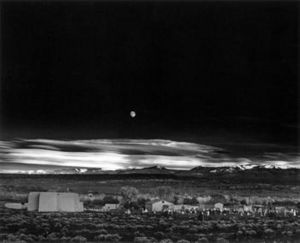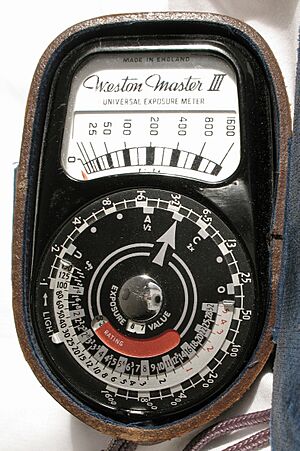Moonrise, Hernandez, New Mexico facts for kids
Moonrise, Hernandez, New Mexico is a very famous black-and-white photograph taken by the artist Ansel Adams. He captured this amazing picture late in the afternoon on November 1, 1941. It was taken from the side of a highway near a small town called Hernandez, New Mexico. The photo shows the Moon rising high in a dark sky. Below it are small houses, a church, and a graveyard full of crosses. Snowy mountains stand tall in the background. Adams took this single photo just as the setting sun lit up the white crosses and buildings. People have tried to figure out the exact date it was taken using clues from the Moon's position. It is one of Adams' most popular works.
How the Photo Was Made
In October 1941, Harold L. Ickes, who worked for the US government, hired Ansel Adams. Adams was asked to take pictures of lands managed by the Department of the Interior. These photos would be used as large prints to decorate a new museum.
Adams went on a long road trip across the western United States. His young son Michael and his good friend Cedric Wright joined him. They were driving through the Chama River valley one afternoon. Suddenly, they saw the incredible scene that would become Moonrise.
The first time Moonrise was shown to the public was in late 1942. It appeared as a two-page picture in a book called U.S. Camera Annual 1943. Adams later shared more exciting details about taking the photo.
He remembered seeing a "fantastic scene" – a church and cemetery near Hernandez. They quickly pulled their car to the side of the road. Adams recalled yelling at his son and friend, "Get this! Get that, for God's sake! We don't have much time!" He was desperate to capture the image before the light disappeared. They rushed to set up the camera and tripod. They knew they only had moments left.
Adams also shared that he couldn't find his exposure meter. An exposure meter is a tool that helps photographers measure the light. This tells them how to set their camera for a good picture. He realized he knew how bright the Moon was. He used this knowledge to set his camera perfectly. As he pressed the shutter, he knew he had a special photo. He quickly tried to take a second one. But as he got ready, the sunlight left the white crosses. He was just a few seconds too late! This made the first photo even more valuable.
Finding the Photo's Exact Date
Beaumont Newhall, a photographer and friend of Adams, was curious. Adams didn't know the exact date he took the famous photograph. Adams remembered it was in the autumn. But he had given different years, like 1940, 1941, or 1942.
Newhall wondered if the Moon's position in the photo could help. He asked David Elmore, an expert in astronomy. Elmore looked at the autumn months from 1941 to 1944. He found 36 possible dates for the picture. Elmore figured out where Adams was standing and which way his camera was pointing. Then, he used a computer to plot the Moon's position for those dates. He found a match and believed Moonrise was taken on October 31, 1941, at 4:03 p.m. Adams thanked Elmore and used this date in his later books.
Later, Dennis di Cicco from Sky & Telescope magazine read about Elmore's findings. He tried to check them himself. He put the location, direction, and time into his own computer program. But the Moon's position didn't match the photo. He was very interested in this difference. After working on it for ten years, he visited the actual spot.
Di Cicco concluded that Adams was standing about 50 feet west of where Elmore thought. His calculations showed the photo was taken at 4:49:20 p.m. on November 1, 1941. Elmore agreed with Di Cicco's new result. It turned out Elmore's computer screen had a slight problem that made the Moon's position look a bit off.
The Photo's Value
The photograph became even more famous as time went on. In 1971, a print of Moonrise was sold at an auction for $71,500. The same print was sold again in 2006 for $609,600 at a Sotheby's auction.
In October 2021, a very large print of the same photograph sold for $930,000 at Christie's in New York.
Another print of Moonrise, Hernandez, New Mexico was sold for $381,000 in April 2023. This print had been given directly to Peter Bunnell by Ansel Adams himself in 1959.
Images for kids





